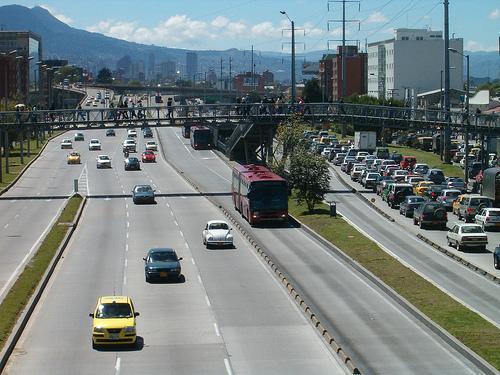It really fucking sucks that the auto industry lobbied the US government so goddamn hard in the 30’s - 70’s and got so much of this country built on car centric infrastructure while also systemically dismantling countless forms of public transit nationwide too. Most major cities and metropolitan areas used to have a pretty comprehensive streetcar system, yet where are they now? That’s right, manufacturers like GM bought majority stakes in those companies and then had their infrastructure dismantled all in the name of “progress.”
As far as I’m aware, the only city in the western world that truly kept its pre-automobile streetcar network was Melbourne, Australia. A result is it today has the largest tram network of any city in the world.
It hurts my soul to imagine how basically every city in North America had similar networks, but they were almost completely annihilated, save for small fragments in a small handful of cities.
Toronto, Canada has kept its streetcar network since they were horse drawn. Today the network is 83km long, or a third of Melbourne’s.
Technically Australia is east of the international date line so it’s not even really the western world.
Most of the people there are white so it counts as Western
This. I don’t even have a bus I could walk to oj under an hour’s walk. And the buses come every 30 min to an hour. It’s brutal.
I did a bicycle+light rail for a year and it took me about 2x the time to get everywhere I needed to go, but I could do it in a car centric city. You can’t expect rural folks to have access to public transportation though. Suburbs are a stretch too in some areas.
Why can’t we expect rural areas to have some form of mass transit? Having at least a bus system that services a rural area absolutely should be the expectation.
Because a bus that serves a town of 500 people will come once an hour, at most. Also, many people can’t walk far to/from the one bus stop. Busses do not solve a problem in small towns, because there is no traffic and plenty of parking.
Switzerland has rail that serves small towns and it’s pretty frequent: https://youtu.be/muPcHs-E4qc
@KevonLooney@lemm.ee, @Blamemeta@lemmy.world, @bob_wiley@lemmy.world
It seems that you’re all only thinking about servicing just the small town itself, and not a larger bus line that services multiple smaller towns to get them to a larger city area and back, or to each other.
The usefulness is not in traversing the rural town. It’s to get the fuck out of one.
deleted by creator
The larger city area will often be hundreds of miles away with not enough population in between to have more than one or two people at most in any given bus even stopping at multiple small towns. Mass transit it great in cities, but it desperately needs population density to be efficient.
The larger city area will often be hundreds of miles away
How large is large? How are people getting goods at all living hundreds of miles away from a population center? It doesn’t have to be a giant metropolitan like LA or NYC.
The same idea @DrAnthony@lemmy.world is putting into words better.
Gosh, I think you’d have to be in the REAL middle of nowhere to be even 100 miles from a population center. Maybe out west in either of the Dakotas or Wyoming or something, but I imagine even then it’s quite rare and represents a fraction of a percentage point of the population. “Never let perfect be the enemy of good”
How large is large? How are people getting goods at all living hundreds of miles away from a population center?
Usually you consolidate all your errands into one trip every week or two where you buy everything you need at the larger town of a few tens of thousands of people.
My grandmother lived in rural Kansas, and her town had a grocery store and a gas station. Anything else was a 3 hour drive to buy.
That’s…not a place I’d want to spend my life at
The final mile is always the killer. And the greater the number of destinations, the more complex and impractical a mass transit system becomes. This is the fly in the ointment that nobody ever seems to want to address directly.
Yes, a car is inefficient in terms of number of ass cheeks moved per square footage taken up. However, every single one of those cars can (and probably is) delivering its occupant to a different destination, and in most cases practically directly to it. A train cannot do this. A bus cannot do this. Trains are excellent at moving a large number of people from a relatively small high concentration geographical area to another single location with a high demand destination nearby. A bus is decent at moving a moderate number of people along a predefined corridor, provided the passengers do not have particularly specific requirements of when they leave or arrive. But the more stops you add for the bus or train, the slower and slower it gets. If you compensate for this by adding more routes, the number of connections a passenger must make to get from one specific destination to another makes the amount of time taken pretty much totally nonviable once you reach 4 or 5.
Single or limited destination mass transit methods can never be a total replacement for individual transportation. However, that individual transportation doesn’t necessarily need to be a car. Bicycles, scooters, and motorcycles are more space efficient per number of passengers, especially if only 1 or 2 passengers need to travel at a time (see also: Southeast Asia).
All of these methods need to coexist to create a functional and balanced transit system. There is no silver bullet, and the issue is much more complex than a single smarmy bar graph.
Putting in even a single stop at a rural town could easily add 30 minutes each way to the route. Probably more, getting from a hub city to these rural towns is a good amount of driving with not much of anything between. A bus that stops at a rural 500 person town once every hour or so isn’t moving enough people to be more efficient than cars. Now you want to do that for every town surrounding a hub city? The economy of scale simply doesn’t exist for rural areas. Even suburbs stretch that a bit.
So basically, they would drive to a bus station, just to get on a bus? How often do you expect them to need to into the city? And they already have a car at this point, why would they get on a bus?
So basically, they would drive to a bus station, just to get on a bus?
Are you for real with this? Have you even ever seen a functioning bus line like this before? No. That’s not basically it at all.
You have a couple stops in the small town direct from the hub/city to pick up and ferry people to the larger area. From there they can walk/take another bus or other form of transport like a train. It’s similar to light rail, but with roads and busses instead of tracks and trains.
how often do you expect people to need to go into the city?
It’d be a lot easier for some people to find jobs who can’t afford their own car if they could actually get to the city where the jobs are. So every day.
Well, yeah. If you have your own car, then there is no reason to use a bus. The only reason to use a bus is if you don’t have a car, like you got multiple DUIs or you just totaled your car, but even then you would probably just get a taxi or uber.
Nobody was arguing that, though, so it’s irrelevant to the conversation.
Your town underinvested in transit because everyone has a car, and they sprawled the architecture because everyone has a car. People got by in rural areas with trains just fine before cars were invented
I would love a better bus or LR in my town, but that shit ain’t happening in my life time.
The bus comes every hour, if that, and doesn’t really go to many places.
If I went full public transit, I’d have to schedule the county transportation via state health insurance and schedule the whole week in advance just to even get to a bus stop…and that’s if I even have medicaid.
I try not to drive as much as possible, make my errands all at once, or while en route to and from work. Me and partner car pool. We have one hybrid vehicle.
The other people round here LOVE their coal rollers.
Why don’t you join the transit movement and push for light rail in your town? You could make some persuasive arguments to the local government. Strong transit systems lead to higher GDP and more tax revenue
I don’t mean to be a doomer…but that would probably just be me yelling at clouds to a bunch of out of touch backwoods gangsters. However its worth a look into what is going on in my area. Also worth noting we do have a bus line for commuting into NYC once a day real early AM. So it’s not all doom and gloom I suppose.
Having grown up in a rural area, here’s what I think the solution would look like.
- streetcars within towns
- Roads dedicated to cars that pass next to towns, and moving the bulk of parking to a ramp just within the town limits
- “Frequent” (think once every hour) bus stops from town to town
- A train hub for the local area to desirable areas like cities
Why can’t people in a 500 person town walk to the bus station? How is there traffic in them?? WHO IS PLANNING THIS
deleted by creator
It’s all a bit chicken-and-egg. The more people that use a public transport network, the more economic it becomes to put on more frequent services and additional routes. A town of 100k people is more than enough to sustain a pretty comprehensive public transport network, if most of them are using it. But obviously if most people don’t use it, those that do are stuck with whatever can be made to work.
I live in a much larger city and this is true. I can drive my car to work in about 12-15 mins or it would take roughly 1.5-2 hours to walk or take a bus. When traffic was low due to Covid I nearly bought an e-bike because I could get to work in about 30 mins. If I tried that now I would certainly be hit by a car in a month or less.
And the trains/busses absolutely have to show up at these intervals to make them attractive and viable for most people, which means that for significant portions of the day they’re basically going around empty.
+1 to this. Buses might not be the best mode for most in rural areas, but they are an essential lifeline for those who can’t or can’t afford to drive.
Because at that point you’re just running buses for individuals at best, but mostly running empty. You’d have to stop at every house… It would create more emissions that it saves.
Ideally, you would be running a train instead of a bus. The train stops in the middle of town, which is a thriving mixed use area of medium density residences, corner stores, and restaurants. Everyone can walk to the train station.
You expect people to walk to a train station? Have you seen how far apart everything is in rural areas?
Hi, yes please, Id like to walk two hours to get on a train, and I like to walk two hours to get back home when do. And thats assuming you live fairly close to town, within 5 or 6 miles or so.
People have been walking through rural areas for 12,000 years. Because that’s how long ago agriculture was invented.
Except you know, horses.
Also, we have cars now.
And its not 12,000 years ago.
There is zero point in getting in walking two hours to a train station when you can just drive there.
One of those options emits carbon and drives humanity closer to extinction and one doesn’t. Do you prefer the time saving convenient genocide, or walking?
Have you looked at a voting map recently? They would never go for it, not in America at least.
Removed by mod
Now I can only speak for the US, but most major cities have ring roads or some sort of bypass that would be perfect for a hub and spoke sort of setup alongside them. Maybe it’s just the fact that the university I went to famously has a light rail system and the concept is just embedded in me, but I’d imagine the uptake of a park and ride approach with stations out in the burbs (certainly not all of them, but laid out so that you don’t need to go more than a burb or two over to reach a station) would be high enough to be worth it. Putting in some shops at the stations like an airport foodcourt would help offset building costs and whatnot to a degree over time as well. Then you could tie the hubs into other major cities in the state and you’ve got yourself a compelling transit system, doubly so if those cities have subways.
A benefit of starting with a park-and-ride setup is, if you have good protected bike lanes and secure bike parking, you can encourage a lot of bike and ebike trips to the transit hubs. If every suburb isn’t too far from a transit hub, that makes a compelling case for bikes and ebikes as first- and last-mile solutions for a lot of people. Maybe not everyone, and maybe not overnight, but definitely for a lot of people. And any improvement is still improvement.
I understand what it means, but “last mile” is a really funny term because walking a mile is apparently inconceivable to the average american
Man, I’m fat as fuck and I still regularly walk 2 miles to go get junk food. 1 mile there, 1 mile back. Once walked 5 miles cuz I got lost on a hiking trail and that sucked. But mostly due to being lost in the god damn woods.
You know, the bike wrinkle is something I hadn’t even considered. That’s an awesome point and all the more reason why we need to build a better transit system.
Multimodal transport is amazing. Ride bike to station - ride a fast train - ride from station to destination.
When I switched to riding my bike to work the commute was almost identical. However, I was riding in traffic and after my second close call with a car door I called it quits.
If we had dedicated bike lanes where I live I would 100% still be riding to work.
That’s why we need to build trains and trams in rural and suburban areas to save time and money
deleted by creator
that’s a problem with the city and not with public transit. there are many cities where public transit is safe, it always depends on the general safety of the city
deleted by creator
deleted by creator
There was a woman who would beg for money on the last stretch of my commute home. Either she was on the bus or she must have been coming back from the other end of the line.
Every now and then she would start shrieking. Once she started she just… Didn’t stop. She would walk the length of the bus shrieking directly in people’s faces. This happened about a dozen times before I just started getting off the bus if I saw her. I would rather walk 30 minutes then have to put up with her.
I’m my country the transit system won’t ban anyone because it is considered excessive punishment for the extremely poor.
As a result, transit just sucks for everyone.
Behavior that is anti-social should be unacceptable. We’re so afraid of placing limits on anyone that the most unstable/unwell place limits on the rest of us.
In the case of the woman I mentioned, she’s also a victim. There’s no proper support for her. She needs help too.
That’s illegal in Denmark, i have seen people do this kind of things sometimes and everytime they are kicked off the transport at next stop. And then they jump on at the next transport and kicked off again, this behavior have forced the public transport in the big cities to have guards on board the trains all the times.
It’s not fair to her, banshees should also be able to take the bus.
Yeah US public transport has issues. I want to be a train/bus/bike person and I am in Europe and Asia but can’t do it in most of the US.
Honestly, these days I feel like it’s hard to claim that driving is “safer”. It feels safer enclosed in your metal box, except for all the other high speed low-intelligence high-rage boxes driving around near you.
I can also respect the frustration of finding crazies on public transit, and won’t try to spin that as a positive - but to me, it speaks towards visibility of the world around you, and willingness to exist in it and change society when it’s broken. It’s like the lords in their manors that “cannot fathom consorting with all that plebeian filth”.
I’m biased. I’m a tall guy, and I’ve had an incident having to stare down a homeless guy that was spewing Asian hate to a poor Korean guy on the train. I’ll keep taking those trains, claim them for the reasonable people.
Yes, but context matters. Nobody is taking a train up the street to get groceries. And using a car (or a huge ass truck) for that is often overkill.
Bikes FTW!
I’m struggling with this average vs potential. If I stand on a 3.5m wide sidewalk on average I’m going to see 15,000 people pass me by? And there is no room for potential improvement as the sidewalks are completely full on average? And how are we figuring cars can potentially be improved by 33%? Are all cars 3/4ths full already?
I’m very pro public transit, I’m just unclear what is being shown in this chart.
They’re showing capacity, i.e., a 3.5m sidewalk can move about 15k people per direction per hour. I’m guessing there’s leeway for cars depending on intersection types/design, speed, etc., whereas there is much less variation in average speed for pedestrians.
Average should be a measured real world quantity. A max theoretical value should never be average unless it’s literally always at the max… on average.
The wording on the chart isn’t the best, but I’m presuming they mean average capacity, not average ridership, because every city and every system will have its own factors that can impact the specific capacity of their transit modes. E.g., one system may have double-decker suburban rail vs another’s single-decker, or one system may have articulated buses vs another’s non-articulated. These differences would result in differing capacities, but the purpose of the chart is to show a ballpark number for what the typical capacity of a 3.5m corridor of each type would be, based on averaging system capacities in presumably many different cities.
Inefficient energy wise. Not timewise.
This visualization is space efficiency.
Obviously cars have terrible energy efficiency. The most efficient vehicle is a bicycle, since exercise is good for you it’s arguably negative energy usage.
As for time efficiency, you have to consider car dependent development as a package. Everything spreads out, so overall there may not be an improvement in time efficiency, especially when you factor in the longer travel time of people not in cars. You could even consider the time spent working to pay for the car, or the time lost from people killed by the car, and I doubt cars would come out particularly time efficient then.
And usage of space. And money, at least if you include all the externalities.
They’re measuring how many people can pass through a fixed point in space in an hour, not how long it takes one person to get from point A to point B.
So not really time or energy, but quantity.
Or throughput, which is important in areas with congestion, like busy streets and highways.
Depends on the city and the route. It takes me an hour to get to work by public transit, from my place to the office that’s at the other end of the city. Google maps assures me it’d be longer if I drove, and knowing this city I definitely believe it.
I don’t understand this visualisation. Perhaps I’m lacking context. Anybody willing to do ELI5… maybe ELI15? What quantity is being compared and what are potential passengers?
The context is that they’re showing one metric among many and are hoping you’ll draw the conclusion they want: that cars are an inefficient way to travel. It’d be interesting to see distance and time metrics added. For example, while pedestrian capacity is pretty large, the distance travelled for any specific time period is short, so people aren’t walking somewhere 100 miles away.
Similarly, door-to-door travel time can vary a lot. Suburban commuter rail around here is fast, but you need to drive to the station (because suburbs are designed for cars), wait for a train, commute on the train, then find your way to your actual destination from the station you get off the train at, so that might include walking or public transit.
Obviously, any one of the options can make the most sense in a given situation, but the infographic isn’t trying to show that.
I agree the graphic alone isn’t super clear. I read it as the higher number being the potential capacity (such as in a particularly high-capacity system), and the lower number being the more typical capacity. Consider suburban rail, for instance. Some systems might have double-decker trains and more compact seating that allows for higher capacity, whereas some may have just single-decker trains. The double-decker system will have a higher capacity, whereas the single-decker might be more representative of what the “average” capacity of a suburban rail system might be, while the higher number might be more representative of the “potential” capacity of a suburban rail system when you really push it to its limit.
Unfortunately, I’m immunocompromised, so most of these options are too high risk.
There is always exceptions and in some areas, you have to have some cars. But removing most of the cars and replacing most of the 8 lanes of traffic with alternatives would be more than enough.
I wasn’t even disagreeing. Not sure why I’m being argued against.
From my perspective, they aren’t arguing against you, but argue for your case (you, being immunocompromised, being one of the exceptions they are talking about)
I suppose I’m too used to being on reddit and having people be needlessly aggressive and argumentative. You’re right.
It’s as they said: I’m not arguing against you. I think there is a healthy amount of traffic and cars and your condition is one of the reasons why. I can see how I did come off as doing so, so I apologize for the confusion.
Does “BRT double lane” refer to one 3.5m lane out of two, both together transporting 86k/hour due to leapfrogging efficiencies, or to both lanes together at 7m total? I think it’s important to maintain consistency with the 3.5m theme!
I would guess the former, as a single bus line usually doesn’t run a constant stream of buses nor express routes, but leapfrogging could allow you to run multiple bus lines along the same corridor, allowing for kinda ludicrous capacities.
Based on this data, the minimum headway and maximum current vehicle capacities, the theoretical maximum throughput measured in passengers per hour per direction (PPHPD) for a single traffic lane is some 150,000 passengers per hour (250 passengers per vehicle, one vehicle every 6 seconds). In real world conditions BRT Rio (de Janeiro, BRS Presidente Vargas) with 65.000 PPHPD holds the record, TransMilenio Bogotá and Metrobus Istanbul perform 49,000 – 45,000 PPHPD, most other busy systems operating in the 15,000 to 25,000 range.
Oh wow, I could believe that now! Tried looking up pics of Rio and Bogotá BRT to see if they are two-lane or one-lane. Some pics look as if it’s 2-lane:

But it seems that’s only around stations, the lanes merge into 1 later:

Wow, thanks for digging up some numbers on it. Those systems sure can move a lot of people. I certainly wouldn’t mind having buses show up every 6 seconds.
Efficiency is not the objective. In fact, were all energy and materials used in making and powering cars from relatively renewable sources, it wouldn’t be a problem. I am aware they’re not. All else being equal, efficiency is a worthwhile goal. But the tradeoff for inefficiency here is the freedom to go where you want when you want.
There are places here in Europe, contrary to what some people in this community might claim, that simply cannot be accessed by train. Smaller villages and the like.
Access to a car is useful. Ownership might not be unless you live there. But cars have their place.
But cars have their place.
True. However with all the downsides of cars, they should be only the fallback if most other options don’t work. As it is, in many places, they are the highest priority that everything is planned around.
Yes. Agreed.
I don’t own a car and don’t want to, but I do rent one once in a while.
People don’t drive cars because they think they’re efficient in absolute numbers. They drive cars, because cars are way more comfortable and faster than anything else in everyday life.
They’re only faster because transit infrastructure is built exclusively for cars at the expense of everyone else, including car drivers. Driving during rush hour sucks, but many people don’t have a choice.
Yup. I’d love to ditch my car but it would mean my 20 minute commute would take an hour longer each direction. And this is in (around) Helsinki, Finland, where public transport is really rather good.
The only thing I wish is that we had more accessible and safe single-seat vehicles. I bring 3 empty seats with me to work every day. I would be more than happy to have a cheap, efficient single seat vehicle for commuting if it was safe. I’m not going to ride a motorcycle 25 miles each way every day in the Florida heat and rain. I’m certainly not going to share the road with the maniacs we have here on a motorcycle.
I’m certainly not going to share the road with the maniacs we have here on a motorcycle.
In other words, it isn’t that biking or motorcycling or walking or whatever isn’t safe, it’s that the presence of cars makes everything unsafe (including the cars themselves).
Similarly, bike lanes etc. are car infrastructure, not bike infrastructure, because in the absence of cars cyclists would have no problems using the normal lanes. (Remember that the next time some dipshit complains about spending on bike lanes or cyclists not paying their “fair share.”)
Pretty much every argument drivers have against other transportation modes is rooted in projection.
Smart Cars and the like are closer to this, but roads and parking spaces aren’t really designed to take advantage of their comparatively smaller size (eg you can’t drive them side by side down the road).
To be fair, Europe is sort of like this given how small their roads are
Yeah I wish we had a lot more public transit in the USA but a lot of these arguments do not compare convenience in any way. Most of those rail options are in no way more convenient. Especially for long distance. I took a train long distance once; or was almost as bad as flying in terms of schedule. Being able to come and go on my schedule is one of the biggest bonuses of driving.
That said, fuck cars lol
Ain’t nothing comfortable about being in an environment where one wrong move will end your life
Not to mention how every time you drive a km, you kill a statistical fraction of a person. How do people do that fucking calculus? How many micromorts are you willing to inflict on others just to get some OJ from the store? People DON’T do the fucking calculus, that’s how. They just push it from their minds, like they have been conditioned to by the religion of the automobile ever since birth.
Where is the plane?
Gonna use some of that suburban rail to travel dooway-to-doorway. Oh wait. No, you can’t. It is almost as if having options for different needs is important. Instead let’s use overly simplistic explanations for a rather complicated problem.
deleted by creator
Hey all you people that live in that city, some troll online wants to take away all your choices. Yeah, I know that’s ridiculous and beyond arrogant and ignorant of them, but then again that is why they are a troll.
deleted by creator
deleted by creator
Mods are an incredibly inefficient way to moderate people.














